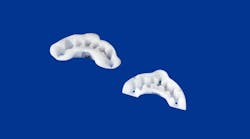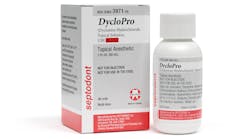Dental hygienists witness the detrimental effects of chronic bruxism in their patients every day in clinical practice. With up to 250 pounds of bite force, the human jaw can permanently alter multiple anatomic structures within the body when used incorrectly.1 Clinical signs such as occlusal and incisal wear, cervical abfraction, cracked or fractured enamel, and broken restorations often indicate the occurrence of undesirable parafunctional habits like clenching and grinding. In many cases, the patient may also develop joint, facial, head, neck, ear, and shoulder pain that can significantly impact their quality of life.
Immediate solution for long-term pain relief
Dental practices typically respond to these findings by recommending a lab-fabricated occlusal splint, but when a patient is in acute pain, waiting weeks for relief can feel like an eternity. Additionally, many patients have difficulty comfortably tolerating the bulkiness of a full-arch oral appliance. In recognizing these common problems, the GrindRelief PRO was developed as a “right now” solution for long-term pain relief and muscle hyperactivity reduction that many patients experience with clenching and grinding habits.
Unlike the traditional flat plane splint that is designed to cover the entire upper or lower arch, the GrindRelief PRO acts similarly to the Nociceptive Trigeminal Inhibition (NTI) device, increasing the vertical dimension between the upper and lower jaw and reducing the wearer’s ability to activate clenching and grinding muscles.2 What differentiates the GrindRelief PRO from the NTI device, however, is that all of the upper and lower anterior teeth remain in gentle contact, as opposed to only the central incisors in a more conventional anterior bite stop configuration. The design is also more suitable for patients with atypical occlusion. Once seated over the appropriate teeth, bite pressure is concentrated at the midline and is supported by the central power bar—a feature that drastically reduces the wearer’s bruxing power.
The GrindRelief PRO device can be easily fitted to the patient’s upper or lower anterior teeth within minutes during a typical hygiene visit. The appliance is placed in hot water for 90–120 seconds to soften the thermoplastic liner, then positioned over the appropriate teeth. The patient will then bite down on the guard to create a secure, custom fit. After removal, the fitted appliance is placed in cool tap water until completely set and can be sent home with the patient the same day for immediate use.
The device can be worn day or night—whenever bruxing habits are active. Patients can expect a snug fit that will keep the guard safely in place for as long as desired. Upon insertion, the wearer will notice that the facial muscles quickly relax as occlusal force is transferred from the posterior teeth to the guard’s central power bar. This reduces muscle tension in the face, neck, and shoulders, and can assist in significantly decreasing tension headaches, migraines, and even vertigo.2 For patients who live with chronic pain in these areas, relief can change their entire outlook on life.
Simple, affordable, fast and effective
Bruxism is a complex, multi-faceted issue, but the solution doesn’t have to be. The dental hygienist can provide an affordable, “right-now” answer to the problem that plagues millions of dental patients across the nation with GrindRelief PRO. Rapid pain relief related to clenching and grinding is possible and can be provided chairside within minutes—just one more reason for patients to appreciate their preventive visits.
Editor's note: This article appeared in the April/May 2024 print edition of RDH magazine. Dental hygienists in North America are eligible for a complimentary print subscription. Sign up here.
References
- Nishigawa K, Bando E, Nakano M. Quantitative study of bite force during sleep associated bruxism. J Oral Rehabil. 2001;28(5):485-491. doi:10.1046/j.1365-2842.2001.00692.x
- Stapelmann H, Türp JC. The NTI-tss device for the therapy of bruxism, temporomandibular disorders, and headache - where do we stand? A qualitative systematic review of the literature. BMC Oral Health. 2008;8:22. doi:10.1186/1472-6831-8-22
Bethany Montoya, BAS, RDH, is a practicing dental hygienist, editorial director of DentistryIQ’s Clinical Insights newsletter and a key opinion leader. She has advanced knowledge and training in complex cosmetic dentistry, dental sleep medicine, and implant dentistry. Recently, she has devoted her time to dentistry’s personal and interpersonal aspects through her social media brand, @humanrdh. Contact Bethany at [email protected].








